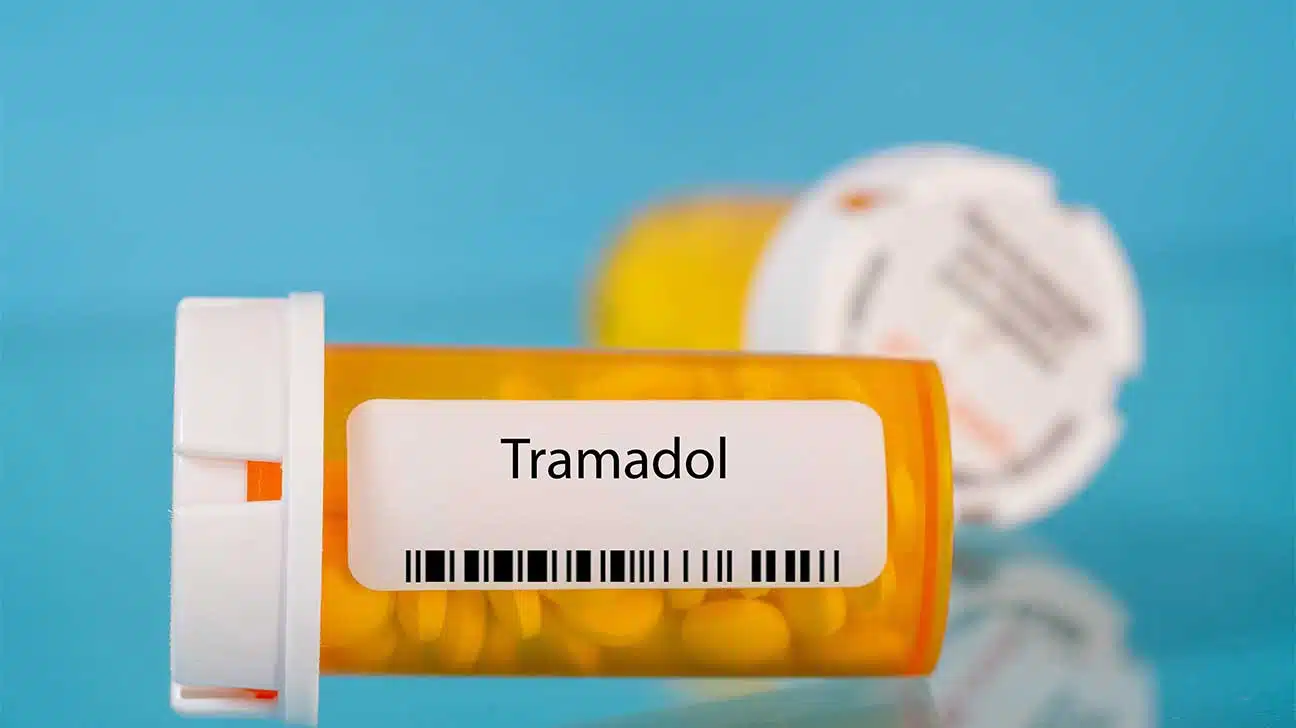
The prescription drug tramadol is used for moderate to severe pain relief. When tramadol is used in accordance with its label, the effects usually last between four and six hours.
Beyond the drug’s initial effects, tramadol can stay in your system for several days, enabling prolonged detection and additional side effects
What Is Tramadol?
Tramadol is a medication known by the brand names Ultram and ConZip. It is similar to Vicodin and fentanyl, which all work by binding with opioid receptors in the central nervous system.
Tramadol primarily targets the mu receptor as a partial agonist. It also reduces the reuptake of serotonin and norepinephrine, so naloxone cannot fully reverse a tramadol overdose.
Tramadol is usually used to treat pain that does not respond to non-opioid pain meds, but it may also be given for off-label indications, such as restless leg syndrome (RLS).
Opioid analgesics, like tramadol, are highly addictive. As such, any deviation from a prescription is considered tramadol abuse and comes with the risk of opioid addiction.
Short-Term Effects Of Tramadol
Tramadol is a complex drug that suppresses some forms of central nervous system activity while enhancing others. The short-term effects of tramadol last between four and six hours.
Common side effects of tramadol include:
- headache
- drowsiness
- shaking
- constipation
- muscle tightness
- anxiety
- mood swings
- dry mouth
Factors That Influence Duration
The effects of tramadol generally last between four and six hours. This range may be affected by a number of different factors determined by your prescription and personal medical history.
Dosage
A higher dose will not necessarily extend the duration of tramadol’s initial effects. Rather, it is more likely to increase the intensity of those effects.
With that said, a higher dose will cause the drug to stay in your system longer and will increase the length of time tramadol can be detected on a drug test.
Frequency Of Use
Someone who uses tramadol frequently is more likely to notice that the effects of the drug do not last as long as they used to thanks to increased tolerance.
However, frequent use may prevent the drug from being fully metabolized prior to the next dose. In this case, tramadol can build up in your system, making it easier to detect for longer periods.
Size
The physical size of a person can certainly contribute to the way a drug affects them.
When all other factors are equal, a smaller person who uses tramadol will likely experience a slightly longer period of efficacy in comparison to a larger person.
Metabolism
Your metabolic rate will also affect the duration of tramadol. This is one of the most unpredictable factors determining the duration of a drug’s effects.
Your genetics, lifestyle, and the current health of your organs can all inform the way your body metabolizes a drug like tramadol.
Length Of Tramadol Withdrawal Period
Tramadol comes with a risk of addiction even when used according to medical advice. This risk is limited, but you should always talk to your doctor if you feel that you’re building a tolerance.
When a person becomes physically dependent on a drug like tramadol, they will typically begin to experience tramadol withdrawal symptoms within 24 hours of their last dose.
These symptoms often feature physical tells, such as shaking and changes in body temperature. However, they can also be psychological. Depression and anxiety are both common.
Tramadol withdrawal can last up to a week. It often requires professional treatment with the help of a medical detox program and an accredited addiction treatment center to prevent.
Drug Testing For Tramadol
People who use tramadol recreationally may have difficulty passing a drug screening. The likelihood of passing will depend on the type of sample, the frequency of abuse, and dosage.
Keep reading to learn about the various tramadol detection times.
Blood
The half-life of tramadol is relatively short. The drug is often detectable in a blood test for less than 24 hours.
Learn more about blood drug testing for tramadol.
Saliva
Saliva tests are not regularly used for opioid detection. These tests can usually only detect tramadol use in the initial hours following the last dose.
Urine
Urine tests are the most common form of opioid drug test. Tramadol can be detected in urine for up to four days following use. The detection window may be longer with frequent use.
Hair Follicle
Hair tests are not usually practical for routine drug tests, but they can be used to track drug use going back several months.
Signs of drug use are first apparent in the follicle approximately seven to 10 days after use.
Long-Term Effects Of Tramadol Abuse
Tramadol is designed for short-term use, not for chronic pain. A physician will generally only prescribe tramadol for more than a week if they are prescribing the extended-release version.
Repeated abuse can cause long-term side effects. Their duration is hard to pinpoint. Some, like physical dependence, are treatable with months of therapy, while others are irreversible.
Long-term tramadol use is associated with a number of serious side effects, including:
- physical dependence
- seizures
- mental health disorders
- serotonin syndrome
- Alzheimer’s disease
- Parkinson’s disease
FAQs Regarding Tramadol
Tramadol is a complex pain medication that is used for legitimate medical purposes. Knowing its properties can help to reduce instances of abuse and addiction.
To help you learn more about tramadol, our team has put together short responses to your most pressing questions.
What Forms Does Tramadol Come In?
Tramadol can be administered in an immediate-release tablet, as a solution, and in an extended-release tablet.
What Can Cause Negative Interactions With Tramadol?
Tramadol should never be used with alcohol or other central nervous system depressants. These include other opioids and benzodiazepine drugs.
You should avoid tramadol if you have a history of asthma or other chronic respiratory conditions.
Can Tramadol Cause Adverse Effects When Used According To Medical Advice?
Following your prescription is the best way to avoid the adverse effects of tramadol. However, that does not guarantee the total absence of these effects.
Contact your healthcare provider if your dose feels less effective or if you begin to experience cravings. Other adverse effects can include hives, headaches, and nausea.
What Is The Best Treatment For Tramadol Addiction?
Tramadol addiction often responds well to medical detoxification and long-term inpatient treatment. However, that does not necessarily mean that is the only successful approach.
To find the best treatment options for addiction and co-occurring disorders, discuss your individual needs with an accredited addiction treatment facility.
Can Tramadol Addiction Be Cured?
Addiction is a chronic health condition that can never be completely cured. Fortunately, addiction can be managed to a point where it becomes a part of your past.
People with a history of addiction have to be careful to avoid triggers and other addictive substances, but you can live a fulfilling life with the right support.
Finding Substance Abuse Treatment
If you or a loved one is abusing tramadol or experiencing another form of opioid addiction, ask for help now.
Our team can help you find meaningful solutions to your substance abuse disorder through an inpatient or outpatient treatment program in your area.
Addiction Resource aims to provide only the most current, accurate information in regards to addiction and addiction treatment, which means we only reference the most credible sources available.
These include peer-reviewed journals, government entities and academic institutions, and leaders in addiction healthcare and advocacy. Learn more about how we safeguard our content by viewing our editorial policy.
- CNS & Neurological Disorders- Drug Targets
https://pubmed.ncbi.nlm.nih.gov/31721720/#:~:text=Long%20term%20utilization%20of%20tramadol,inhibitory%20effects%20on%20GABA%20receptors. - National Library of Medicine
https://medlineplus.gov/druginfo/meds/a695011.html - Stat Pearls
https://www.ncbi.nlm.nih.gov/books/NBK537060/


